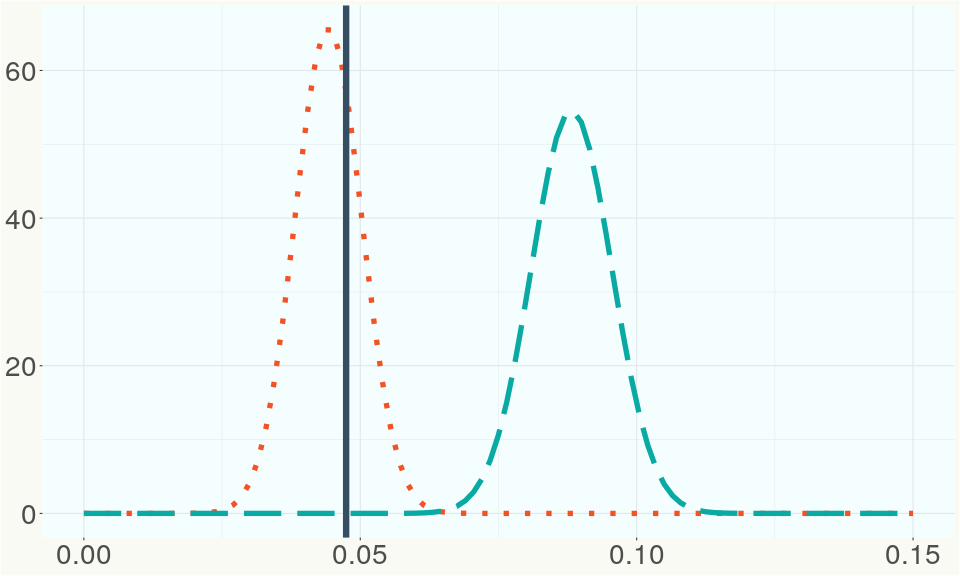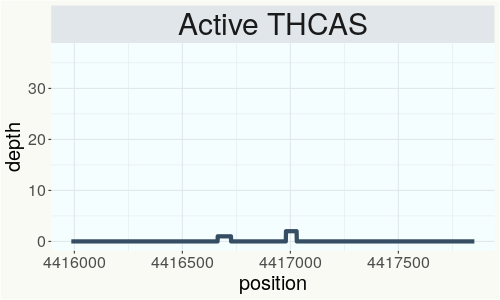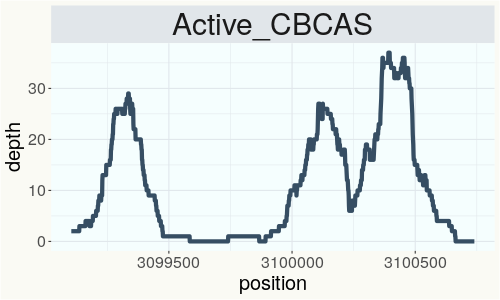Futura 75
RSP 10664
Grower: CSU
General Information
- Sample Name
- Futura 75 5
- Accession Date
- February 14, 2017
- Reported Plant Sex
- Female
- Report Type
- StrainSEEK v2 3.2Mb
- DNA Extracted From
- Leaf
The strain rarity visualization shows how distant the strain is from the other cultivars in the Kannapedia database. The y-axis represents genetic distance, getting farther as you go up. The width of the visualization at any position along the y-axis shows how many strains there are in the database at that genetic distance. So, a common strain will have a more bottom-heavy shape, while uncommon and rare cultivars will have a visualization that is generally shifted towards the top.
Chemical Information
Cannabinoid and terpenoid information provided by the grower.
Cannabinoids
No information provided.
Terpenoids
No information provided.
Genetic Information
- Plant Type
- Type III
File Downloads
The bell curve in the heterozygosity visualization shows the distribution of heterozygosity levels for cannabis cultivars in the Kannapedia database. The green line shows where this particular strain fits within the distribution. Heterozygosity is associated with heterosis (aka hybrid vigor) but also leads to the production of more variable offspring. When plants have two genetically different parents, heterozygosity levels will be higher than if it has been inbred or backcrossed repeatedly.
The ratio of reads mapped to Y-contigs to reads mapped to the whole Cannabis genome (Y-ratios) has been demonstrated to be strongly correlated with plant sex typing. This plot shows the distribution of Y-ratios for all samples in our database which were sequenced with the same method (panel or WGS) as this sample and where this sample falls in the distribution.

This chart represents the Illumina sequence coverage over the Bt/Bd allele. These are the three regions in the cannabis genome that impact THCA, CBDA, CBGA production. Coverage over the Active CBDAS gene is highly correlated with Type II and Type III plants as described by Etienne de Meijer. Coverage over the THCA gene is highly correlated with Type I and Type II plants but is anti-correlated with Type III plants. Type I plants require coverage over the inactive CBDA loci and no coverage over the Active CBDA gene. Lack of coverage over the Active CBDA and Active THCA allele are presumed to be Type IV plants (CBGA dominant). While deletions of entire THCAS and CBDAS genes are the most common Bt:Bd alleles observed, it is possible to have plants with these genes where functional expression of the enzyme is disrupted by deactivating point mutations (Kojoma et al. 2006).



This chart represents the Illumina sequence coverage over the CBCA synthase gene.

Variants (THCAS, CBDAS, and CBCAS)
Variants (Select Genes of Interest)
| PKSG-2a | c.67T>A | p.Phe23Ile | missense variant | moderate | contig700 | 1945567 | A/T | |
| PKSG-2a | c.31A>T | p.Thr11Ser | missense variant | moderate | contig700 | 1945603 | T/A | |
| PKSG-2b | c.948T>G | p.Asp316Glu | missense variant | moderate | contig700 | 1950690 | A/C |
|
| PKSG-2b | c.945T>G | p.Ser315Arg | missense variant | moderate | contig700 | 1950693 | A/C |
|
| PKSG-2b | c.944G>A | p.Ser315Asn | missense variant | moderate | contig700 | 1950694 | C/T |
|
| PKSG-2b | c.934C>G | p.His312Asp | missense variant | moderate | contig700 | 1950704 | G/C |
|
| PKSG-2b | c.31A>T | p.Thr11Ser | missense variant | moderate | contig700 | 1951851 | T/A | |
| DXR-2 | c.431C>G | p.Ala144Gly | missense variant | moderate | contig380 | 287760 | G/C | |
| aPT4 | c.517A>T | p.Ile173Leu | missense variant & splice region variant | moderate | contig121 | 2830795 | A/T |
|
| aPT4 | c.634C>A | p.Pro212Thr | missense variant | moderate | contig121 | 2830912 | C/A |
|
| aPT4 | c.757G>T | p.Val253Leu | missense variant | moderate | contig121 | 2831364 | G/T |
|
| aPT1 |
c.95_97delGT |
p.Cys32del | disruptive inframe deletion | moderate | contig121 | 2835800 | ATGT/A | |
| aPT1 | c.160A>C | p.Thr54Pro | missense variant | moderate | contig121 | 2835867 | A/C | |
| aPT1 | c.406A>G | p.Ile136Val | missense variant | moderate | contig121 | 2839605 | A/G | |
| aPT1 | c.670T>A | p.Ser224Thr | missense variant | moderate | contig121 | 2840278 | T/A |
|
| aPT1 | c.727G>T | p.Glu243* | stop gained | high | contig121 | 2841362 | G/T | |
| HDS-2 |
c.82_93delGT |
p.Val28_Thr3 |
conservative inframe deletion | moderate | contig95 | 1989748 |
CGTAACCGGAAC |
|
| HDS-2 | c.127T>G | p.Ser43Ala | missense variant | moderate | contig95 | 1989794 | T/G |
|
| HDS-2 | c.679G>C | p.Gly227Arg | missense variant | moderate | contig95 | 1990632 | G/C |
|
Nearest genetic relatives (All Samples)
- 0.176 Santhica27 (RSP10056)
- 0.189 USO31 (RSP10233)
- 0.189 Ferimon 12 (SRR14708233)
- 0.192 Santhica27 (RSP11047)
- 0.193 Santhica27 (RSP11046)
- 0.193 Ivory (RSP10668)
- 0.195 Santhica 27 (RSP10665)
- 0.195 Monoica (RSP10241)
- 0.196 C-930 lot 211005 (RSP12603)
- 0.197 Lovrin (RSP10658)
- 0.197 Beniko (SRR14708275)
- 0.198 VIR 507 - Krasnodarsky 10 FB (SRR14708229)
- 0.198 USO 31 (RSP10983)
- 0.199 R1in136 (SRR14708226)
- 0.200 R1in136 (SRR14708227)
- 0.201 Fedora 17 (RSP11203)
- 0.202 Fedora 17 (RSP10661)
- 0.203 Santhica 27 (SRR14708211)
- 0.203 VIR 223 - Bernburgskaya Odnodomnaya - bm (SRR14708217)
- 0.203 USO 31 (RSP10981)
Most genetically distant strains (All Samples)
- 0.435 Chem 91 (RSP11185)
- 0.431 Cherry Blossom (RSP11323)
- 0.427 Cherry Blossom (RSP11300)
- 0.425 Cherry Blossom (RSP11312)
- 0.425 Cherry Blossom (RSP11298)
- 0.424 Cherry Blossom (RSP11318)
- 0.417 Cherry Blossom (RSP11301)
- 0.414 JL 3rd Gen Mother (RSP11197)
- 0.410 New York City Deisel (RSP11225)
- 0.410 RKM-2018-002 (RSP11093)
- 0.409 Cherry Blossom (RSP11328)
- 0.409 Cherry Blossom (RSP11309)
- 0.409 Cherry Blossom (RSP11311)
- 0.408 Motor Breath #15 (RSP12093)
- 0.408 JL Cross 11 (RSP11512)
- 0.406 GMO x Garlic Breath (RSP12507)
- 0.405 Super Sour Diesel (RSP11191)
- 0.405 Cherry Blossom (RSP11334)
- 0.404 Dog Patch (RSP11725)
- 0.403 CHEM4 (RSP12090)
Nearest genetic relative in Phylos dataset
- Overlapping SNPs:
- 109
- Concordance:
- 78
Nearest genetic relative in Lynch dataset
- Overlapping SNPs:
- 10
- Concordance:
- 8
Blockchain Registration Information
- Transaction ID
-
0fa35b963f2bd0cb
f02e1ae599f2cc40 5bf1869a22cb2b5e b427a4879951b002 - Stamping Certificate
- Download PDF (859.1 KB)
- SHASUM Hash
-
7336345d2e78117fab08a23870ce842a 20e53c2b138608f2 e9a1f62f2579cfd4